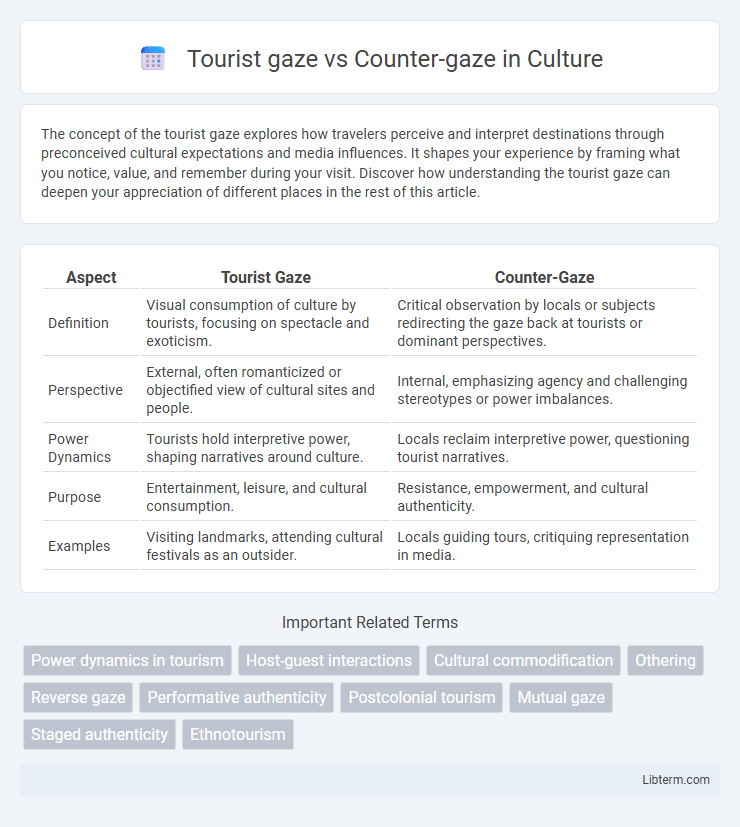The concept of the tourist gaze explores how travelers perceive and interpret destinations through preconceived cultural expectations and media influences. It shapes your experience by framing what you notice, value, and remember during your visit. Discover how understanding the tourist gaze can deepen your appreciation of different places in the rest of this article.
Table of Comparison
| Aspect | Tourist Gaze | Counter-Gaze |
|---|---|---|
| Definition | Visual consumption of culture by tourists, focusing on spectacle and exoticism. | Critical observation by locals or subjects redirecting the gaze back at tourists or dominant perspectives. |
| Perspective | External, often romanticized or objectified view of cultural sites and people. | Internal, emphasizing agency and challenging stereotypes or power imbalances. |
| Power Dynamics | Tourists hold interpretive power, shaping narratives around culture. | Locals reclaim interpretive power, questioning tourist narratives. |
| Purpose | Entertainment, leisure, and cultural consumption. | Resistance, empowerment, and cultural authenticity. |
| Examples | Visiting landmarks, attending cultural festivals as an outsider. | Locals guiding tours, critiquing representation in media. |
Understanding the Tourist Gaze: Origins and Concepts
The concept of the Tourist Gaze, introduced by sociologist John Urry, explains how tourists view and interpret destinations through socially constructed expectations and cultural filters. This gaze shapes tourist behavior and the commodification of places, emphasizing visual consumption of scenic, exotic, or culturally significant elements. Counter-gaze emerges as a critical response, where locals or marginalized groups reclaim control over their representation and challenge stereotypical tourist perceptions.
The Evolution of Counter-Gaze in Tourism
The evolution of counter-gaze in tourism reflects a growing shift from the traditional tourist gaze, which often objectifies destinations and local communities, to a more reciprocal and critical perspective that challenges power dynamics and representation. Counter-gaze empowers local populations by reclaiming their narratives and promoting authentic cultural expressions, fostering mutual respect between visitors and hosts. This transformation influences contemporary tourism practices by encouraging ethical engagement, sustainable interactions, and the dismantling of stereotypes embedded in mainstream tourism imagery.
Power Dynamics Between Tourist and Host
The tourist gaze shapes perceptions by framing hosts as objects of consumption, often reinforcing power imbalances where tourists hold control over the narrative. Counter-gaze emerges as hosts reclaim agency, challenging stereotypical portrayals and asserting their own identities against external objectification. Power dynamics fluctuate as hosts resist marginalization, transforming tourism interactions from passive observation to active dialogue.
Media Representation and Its Influence on Gazes
Media representation shapes the tourist gaze by framing destinations through curated images and narratives that often reinforce stereotypes and exoticism. Counter-gaze challenges these portrayals by enabling local voices and perspectives to reclaim and redefine their cultural identity, disrupting dominant narratives. This dynamic influences how both tourists and locals perceive and interact with each other, impacting authenticity and power relations within tourism contexts.
Tourist Gaze: Impact on Local Cultures
Tourist gaze shapes local cultures by influencing how communities present traditions and heritage to attract visitors, often leading to the commodification of cultural practices. This external perspective can alter authenticity as locals adapt performances and rituals to meet tourist expectations, sometimes diminishing original cultural meanings. The constant observation and framing by tourists impact social behaviors and can create tensions between preserving cultural identity and catering to economic benefits from tourism.
Counter-Gaze: Local Perspectives on Being Observed
Counter-gaze represents a critical local perspective where residents actively observe and reflect on tourists, challenging traditional power dynamics in tourism. This perspective reveals how locals reclaim agency by interpreting, resisting, or reshaping the tourist gaze, emphasizing their narratives and cultural identities. Understanding counter-gaze deepens insights into the complex interactions between hosts and visitors, highlighting the socio-cultural implications of being observed.
Mutual Perceptions: Bridging the Gaze Divide
Tourist gaze and counter-gaze represent two intertwined perspectives shaping mutual perceptions between visitors and hosts, emphasizing power dynamics and cultural representation. The tourist gaze often objectifies and commodifies local cultures, while the counter-gaze challenges stereotypes by asserting authentic narratives and agency. Bridging the gaze divide requires fostering intercultural dialogue and empathy to create more equitable and respectful tourism encounters.
Case Studies: Real-World Examples of Gaze and Counter-Gaze
Case studies of tourist gaze illustrate how visitors often perceive destinations through curated, commodified lenses, shaping experiences based on cultural stereotypes and media representations. Counter-gaze examples reveal local communities actively resisting or reinterpreting these imposed narratives to assert agency and challenge dominant tourist perspectives. In places like indigenous territories in Australia and culturally rich neighborhoods in Latin America, counter-gaze practices empower residents to reclaim visibility and offer authentic narratives beyond tourist expectations.
Ethical Considerations in Tourism Encounters
Tourist gaze often objectifies local cultures by framing them through a consumptive lens, raising ethical concerns about exploitation and misrepresentation. Counter-gaze challenges this dynamic by empowering host communities to assert their own narratives and agency in tourism encounters. Ethical tourism practices must prioritize mutual respect, cultural sensitivity, and equitable representation to foster authentic and reciprocal experiences.
Future Trends: Redefining Gaze in Global Tourism
Future trends in global tourism emphasize the evolution of the tourist gaze toward more interactive and inclusive experiences, where travelers seek authentic cultural engagements beyond superficial observation. Counter-gaze movements empower local communities to challenge and reshape the narratives imposed by traditional tourism, fostering mutual respect and a more balanced cultural exchange. Technological advancements like virtual and augmented reality will play a crucial role in redefining gaze by enabling immersive, ethically conscious tourism that highlights diverse perspectives.
Tourist gaze Infographic

 libterm.com
libterm.com